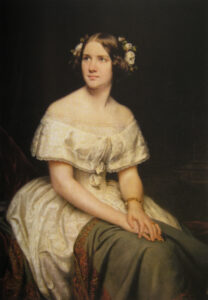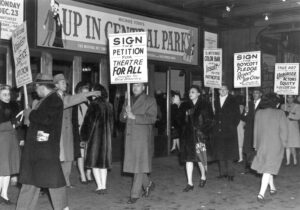November 23, 2021, marks the opening night for our historic theatre’s 186th year and the return to live theatre on Pennsylvania Avenue. Our team eagerly awaits the dimming of the lights, the hushed anticipation of audience members, and the raising of the curtain as we reopen after what will likely go down in history as the world’s longest intermission. While the past 20 months have been particularly challenging, The National has reopened from a few other forced intermissions in our past. Below we explore a few of the occasions that had us close our doors and the events that led to lighting up the marquee again.

In 1845, The National hosted President James K. Polk’s inaugural ball in the auditorium. The day after the festive celebrations, on March 5, a fire broke out in the oil room. Patrons, firefighters, and actors alike tried to put out the flames to save the theatre, but their attempts were unsuccessful, and The National was left in ruins. For five years, little attention was paid to the wreckage of the theatre until news of Jenny Lind, the Swedish Nightingale, and her upcoming travels to the United States reached DC. Henry Willard purchased the ruins down the block from his hotel, the Willard Hotel, and rebuilt a new National in time for great success with two winter concerts in 1850. (You can learn more about Lind and her visit to The National here.)

After another fire (there were a total of four in The National’s history), a hastily constructed King’s Amphitheater claimed The National’s spot on Pennsylvania Avenue. On November 7, 1861, patrons were welcomed to attend circus performances for ¢25 to ¢50. The amphitheater was short-lived and on April 22, 1862, the New National Theatre, also known as Grover’s National Theatre, opened with The Serious Family by Morris Barnett and J.J. of the War Department. Grover’s National Theatre would be a favorite spot for President Abraham Lincoln, who could be seen occupying the President’s Box for countless performances, including John Wilkes Booth’s debut in Washington in Richard III.

Another infamous reopening for The National occurred in more recent history. In 1948, The National closed its doors after the theatre’s management refused to racially integrate audiences. The theatre, with its downtown DC location, was a site for many protests as the nation and DC were urged to desegregate. After continued pressure during the late 1940s from patrons, activists, actors, and theatre artists to open for Black patrons, The National refused to integrate until DC adopted citywide integration policies and closed the theatre’s doors in July 1948. The National was caught on the wrong side of history and human rights for the ensuing years as it reopened as a movie house without addressing the inequities in its policies. Eventually, The National changed management and, in 1952, the theatre was brought back to life with Call Me Madam as a fully integrated Equity playhouse. (You can learn more about this part of The National’s history here.)
As the oldest, continuously operating entity on Pennsylvania Avenue, a street steeped in local, national, and global history, The National Theatre has witnessed, and participated in, both uplifting and challenging events over the last 185 years. And while we will once again add to our history by re-opening our doors on November 23, 2021, our dedicated team worked diligently on (i) exploring ways to reach our audiences virtually through our free educational and outreach programs, (ii) researching our past and how it influenced our physical building and our role in the DC community, and (iii) committing to focus on Equity, Diversity, Inclusion, and Anti-racism initiatives in 2021 and beyond. Therefore, in some ways, The National never really closed its doors in 2020 at all!